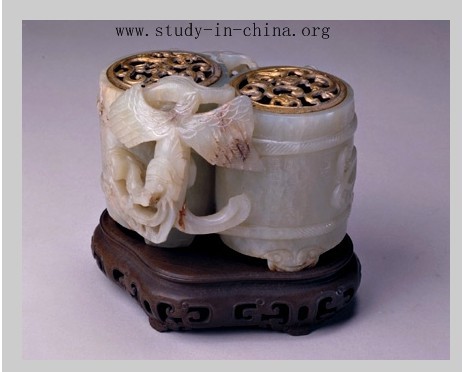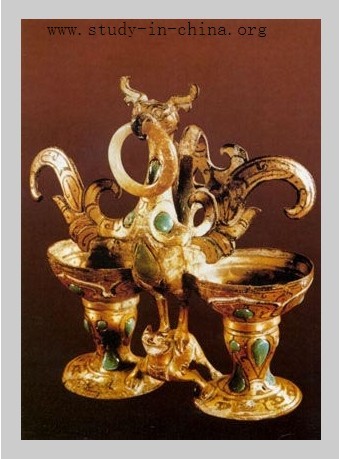more>>More News
- National Day
- ways to integrate into Chinese style life
- Should they be in the same university with me?!!
- Chinese Ping Pang Legend: the Sun Will Never Set
- A Glance of those Funny University Associations
- mahjong----The game of a brand new sexy
- Magpie Festival
- Park Shares Zongzi for Dragon Boat Festival
- Yue Fei —— Great Hero
- Mei Lanfang——Master of Peking Opera
Hejin Cup, Drink to Happiness
By admin on 2015-02-02
March 31, 2009 -- Taking a cup of Jiu (alcholic beverage) and crossing arms, lovers sip the juice of romance and promise in the presence of guests their lifelong love—this is perhaps the happiest moment in the world for many Chinese.
This ceremony of newlyweds linking arms and drinking to their future happiness (Jiaobaiju) is common during Chinese weddings today.
In ancient times, a similar ceremony called Hejin was also widely practiced. He means join together; while jin means gourd ladle, which is made by cutting a gourd in half. As the bride and groom hold a gourd ladle to drink wine, the hejin ceremony symbolizes a harmonious matrimonial life.
Gourd ladles are the oldest form of hejin cups. Later, double cups were made allowing newlyweds to hold two handles and drink together.
Not many of these cups were made and very few of them
have survived in a good condition.
Hejin Cup Lu Zigang
The Ming Dynasty
(1368-1644)
Gray jade
7.5 cm tall and 13 cm wide
At the Palace Museum established in the Forbidden City, there is a hejin cup made of gray jade. It was designed for the weddings of emperors.
The exquisite cup has relief and openwork carving. With the two cups joined together, it is 7.5 cm tall and 13 cm wide, and stands on six feet shaped like animal heads.
On one side, between the two cups, is a handle shaped like the tail of a phoenix, on the opposite side are two dragons whose tails wind around the cups to join the phoenix. Two decorative ropes are carved on the upper and lower parts of the cups, as if binding the cups tightly together. Where the ropes knot are carved two words, wan shou, or longevity.
There are two poems on the cups: One describes how the gray jade was carved to contain wine; the other talks about sun and smoke, and wishes the emperor longevity and a harmonious married life.
There are three more characters on the cups, "Zigang Zhi", the name of the renowned jade carver Lu Zigang who made the cups.
When a grand wedding was held in the Forbidden City, the emperor and empress would spend their first night together in the Eastern Warm Pavilion of the Palace of Earthly Tranquility.
The interior walls of the room are painted bright red; the eastern and western gates are each shielded with a giant wooden screen bearing the words "double happiness". To the south of the room is a huge bed where the emperor and empress would enjoy their meal and pick up the hejin cup to drink wine together.
Collected by the Palace Museum
The inside of the cups here are not connected, but the exterior is decorated with an eagle that is unfolding its wings and has a bear below its feet. Popularly known as an "eagle-bear"cup, the Chinese characters for this term are a homonym for "hero", which is why it is also known as a "hero cup."

Bronze Hejin Cup
Western Han Dynasty (206BC-24AD)
Bronze
11.2 cm tall
Collected at Institute of Archaeology, Chinese Academy of Social Sciences
In 1968 two tombs were found in present-day Mancheng County in Hebei province. The first undisturbed royal Western Han tombs ever discovered, they belong to the prince Liu Sheng (165-113 BC), who was a son of Emperor Jing Di, and Liu Sheng's wife Dou Wan.
Unearthed in the tomb of Dou Wan, this bronze hejin
cup is decorated with a bird that expands its wings and has a jade cup in its
mouth and an imaginary beast below its feet. It’s the wedding memento of the
prince Liu Sheng and his wife Dou Wan.
- Contact Us
-
Tel:
0086-571-88165708
0086-571-88165512E-mail:
admission@cuecc.com
- About Us
- Who We Are What we do Why CUECC How to Apply
- Address
- Study in China TESOL in China
Hangzhou Jiaoyu Science and Technology Co.LTD.
Copyright 2003-2024, All rights reserved




 Chinese
Chinese
 English
English
 Korean
Korean
 Japanese
Japanese
 French
French
 Russian
Russian
 Vietnamese
Vietnamese
